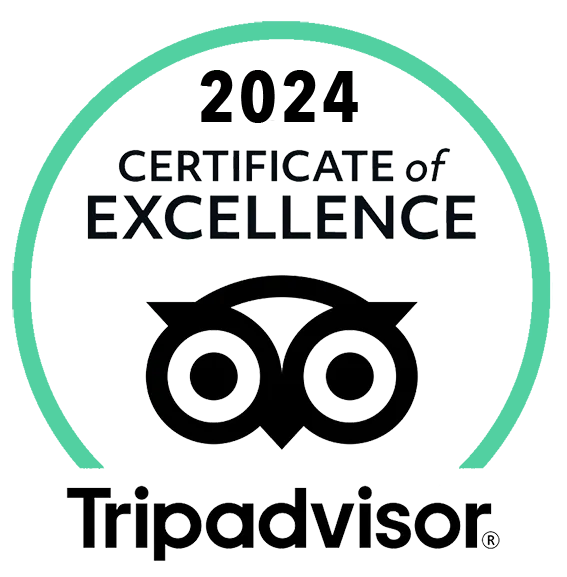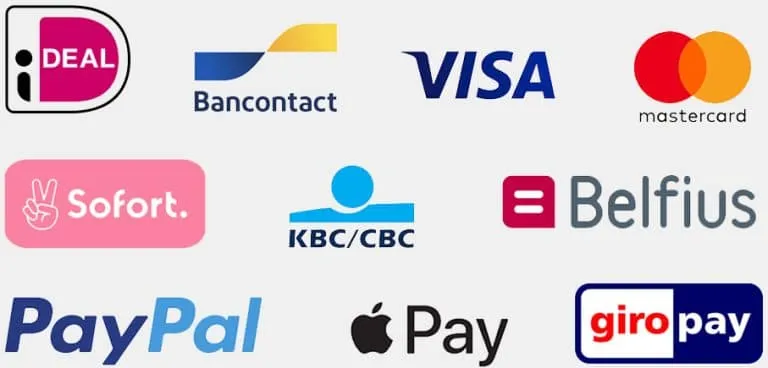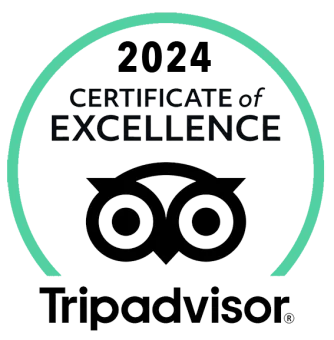Page content:
Klein Curacao info
Klein Curacao is located 10km southeast of Curacao . It is an uninhabited, tropical, bounty island in the Caribbean Sea with a surface area of 1.7km2.
When you look at the flag of Curacao there are always two white stars on it, one large and one somewhat smaller. The big star represents Curacao and the smaller star represents Klein Curacao.
Features of Klein Curacao
The most striking features of Klein Curacao and what the tropical bounty island offers is the beautiful snow-white beach , an azure blue sea, a beautiful underwater world, a spectacular reef under the crystal clear water, of course a lot of peace and fabulous views.
And not to be missed, the two absolute eye-catchers of the island of course, a must see, the iconic lighthouse, the Prince Hendrick Tower (still working, but now solar-powered) and the beached large oil tanker, the Maria Bianca Guidesman, now the famous rusty shipwreck.

Finally, of course, Klein Curacao is known for the large sea turtles and dolphins that like to hang out around the little island.
Since 1990, the bounty island has only been used for organized day trips. From various locations such as Jan Thiel beach, Caracas Bay and Santa Barbara, you can join a Klein Curacao trip completely all inclusive.

Features of Klein Curacao
Apart from tourism, Klein Curacao also serves as a breeding ground for various animals such as the American Dwarf Tern, Hawksbill Turtle, Soup Turtle and Striped Anolis.
However, Klein Curacao used to have an entirely different function. The small island was used by the West India Company to quarantine sick slaves. The deceased slaves were buried on the island.
Not long after, English mining engineer John Godden discovered phosphate on the islet which was mined in the following years.
The Prins Hendrik Lighthouse
One of the most striking and unique features of Klein Curacao is the old iconic pink lighthouse in the middle of the uninhabited island. There was first a lighthouse built on Klein Curacao in 1849 and this lighthouse was called the Prins Hendrik Lighthouse. Unfortunately, this lighthouse was destroyed during a hurricane in 1877. However, it was important for shipping that there would be a good lighthouse on Klein Curacao, so in 1877 they rebuilt the lighthouse right away. Then, in 1913, the lighthouse was rebuilt into the lighthouse that can still be seen today.
The historic lighthouse is 20 meters high and still has an active status. In fact, Klein Curacao is a rather flat island, making it easy for ships to overlook it. This is how the shipwrecks that remain on the island today ended up there. That is why it is important to have a lighthouse that works well. In 2018, they made another modification to the lighthouse. In fact, the lighthouse now has an LED system that runs on solar power! The lighthouse lamp flashes twice every 15 seconds and its range is 15 nautical miles. This is about 27,780 meters!
What makes the lighthouse so unique?
The reason this lighthouse is unique is first of all its distinctive appearance. Usually lighthouses are white or white with red stripes, for example. The lighthouse on Klein Curacao, however, has a pink appearance. Although the lighthouse itself has a sand color, the outbuildings around it are pink.

This makes the lighthouse look beautiful and unique. Be careful, however, when visiting the lighthouse on Klein Curacao. The floors on the second floor are not solid throughout. However, a complete renovation of the building began in 2017. During phase 1, the roof was renewed and new tiles were also installed. The goal is for the lighthouse to be restored to its full glory.
The shipwrecks
The bounty island has a turbulent past and one of the reasons for this is because Klein Curacao is located on a busy sailing route to and from the ABC islands. Because Klein Curacao is a rather flat bounty island, it is also very easy to miss. As a result, a number of ships have run aground on Klein Curacao in recent years.
The causes of stranding
There is a fairly strong current from the southwest and the wind is generally from the northeast. This can make it difficult for ships as they pass along the east coast of the island. Both north to south and vice versa.
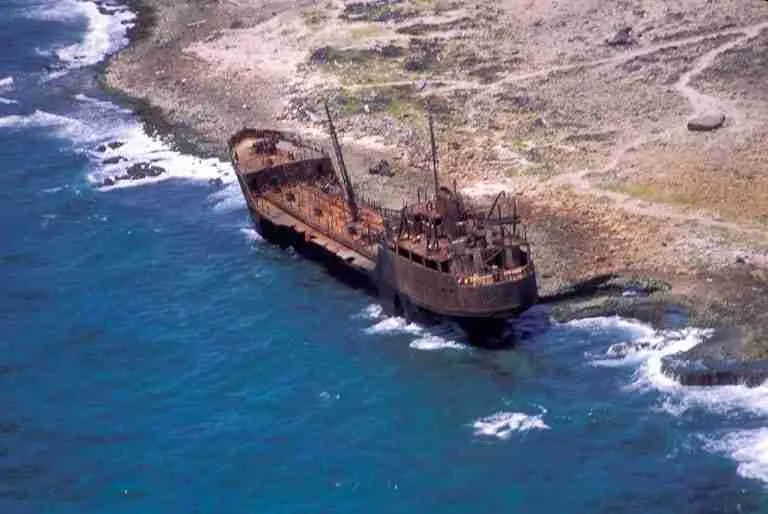
Northeast winds combined with strong currents caused several ships to run aground on the island. As a result, the shipwreck can still be seen on Klein Curacao today.
Which ships ran ashore?
Since the discovery of Klein Curacao, several ships have run aground. The most famous ship of these is an oil tanker called the Maria Bianca Guidesman. This ship ran aground here in the 1980s. The rusty wreck can still be seen on Klein Curacao . It has already decayed considerably, leaving less and less of it.

Of course, this is mainly due to the elements such as wind, rain and sand. Another well-known ship that ran aground on Klein Curacao is the Magdalena. This is a German freighter which was stranded in 1934. However, you can’t see this ship on Klein Curacao anymore. A lot of people spent weeks trying to get the ship unstuck again. In the end, rescue services managed to release it again. They did this by excavating the ship as much as possible. This required a lot of manpower and several tugs.

Animals on Klein Curacao
Sea Turtles
The perfect place to encounter sea turtles in their natural habitat is Klein Curacao. The two species of sea turtles you can encounter while snorkeling or diving are the Hawksbill Turtle and the Hawksbill Turtle. There are a number of differences between these animals. The easiest is that the Soup Turtle is considerably larger than the Hawksbill Turtle; they can grow up to one and a half meters in size. The other differences are a bit more subtle. The Hawksbill Turtle has a rounded beak with a serrated edge and one pair of scales between the eyes as opposed to the beak-like beak and two pairs of scales in the Hawksbill Turtle.
The Hawksbill Turtle
While snorkeling or diving around Klein Curacao, you can admire sea turtles, and one of the species of turtles you may encounter is the Hawksbill Turtle. The hawksbill turtle is a medium-sized species with a shell length of about 90 centimeters. These turtles are mostly found near rocky coasts and shallow waters, making them completely in their element in the sea around Klein Curacao. The hawksbill sea turtle never actually comes ashore, only to lay eggs. Therefore, you will also only be able to see hawksbill turtles when they are laying eggs or when you go snorkeling or diving in the sea. The food of these turtles consists mainly of sponges and other marine plants and animals. This they can find mainly in coral reefs and here, fortunately, Klein Curacao has plenty of them!

The soup turtle
Another sea turtle you may encounter on Klein Curacao is the Soup Turtle. This is the largest turtle of the various sea turtles with a shell length of over a meter. Their diet consists primarily of animal matter, but seagrass and algae may also be eaten by the adults. This makes Klein Curacao the perfect habitat for these turtles! There are more than enough animals swimming in the sea around Klein Curacao and there are more than enough marine plants to be found in the beautiful coral reefs of the bounty island! When the green turtles deposit eggs, they crawl ashore at night for this purpose, so you will rarely see them on the land of Klein Curacao. In the sea, however, you can spot them while snorkeling or diving!

Dolphins
Dolphins are enormously curious animals, which is also one of the reasons they are so often seen around Klein Curacao. Dolphins especially find the waves made by the boats that daily go to Klein Curacao irresistible; they can’t resist coming to take a look. They can swim out in front of the bow wave for up to half an hour and make high jumps out of the water, rotating up to seven times around their own body axis. The dolphins seen by far the most are the Bottlenose dolphin (Whitenose dolphin) and the Longnose dolphin (Spinner dolphin).
Bottlenose dolphin
The Bottlenose dolphin, also called White-beaked dolphin, is one of the most common dolphins in the world. It is a gray dolphin with an ever-friendly snout. Generally, these dolphins live in groups of 5 to as many as 20 animals. The Bottlenose dolphin has developed a large arsenal of sounds with which they can communicate underwater. When you yourself are underwater in the vicinity of these dolphins, this is also very clearly audible. To us, these sounds sound like high-pitched squeaks and clicks.
Often regarded as one of the most intelligent dolphins, the Bottlenose dolphin is the one most commonly seen as a trained, domesticated dolphin in shows.
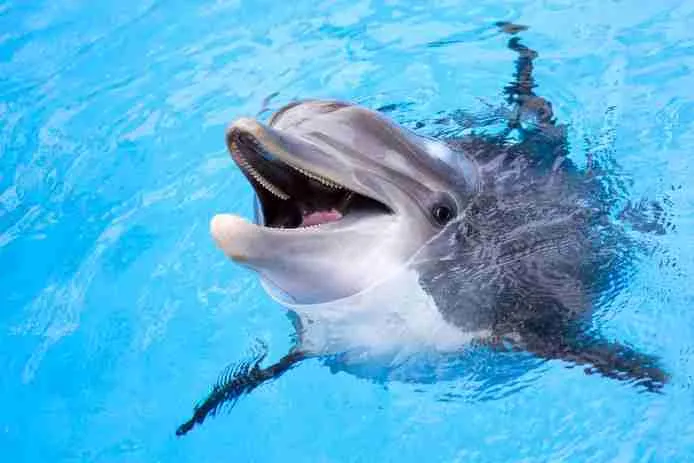
Longnose dolphin
The Long-nosed dolphin is also called Spinner dolphin. Compared to other dolphins, it is a very slender and muscular dolphin, with, as its name suggests, a long snout. The body of the Longnose is somewhat shaped like a torpedo and the tail fin is a bit longer and more pointed than in most other dolphins.
The Longnose dolphin also lives in groups. These groups are often considerably larger than at the Bottlenose dolphin. The numbers generally range between 10 and 100 animals. They generally live off the coast of Curacao and Klein Curacao where they seek the shallower waters during the day to rest from hunting small fish and squid.

The Striped Anolis
The Striped Anolis is a species you do see a lot on the land of Klein Curacao. This tree lizard is fairly large and can sometimes have a head length of up to 8.5 centimeters! Including the tail, these animals can have a body length of 28.5 centimeters. The Striped Anolis is a lizard found only on the islands of Aruba, Curacao, Suriname and Klein Curacao. In the latter two, however, humans introduced the animal to the habitat. So when you take a walk on Klein Curacao, be sure to keep a close eye out for these little animals if you can see them bolt away!

American Pygmy Tern
The American Little Tern is a small bird of only 21 cm. Originally, the bird’s range was on both the Gulf and East Coast and the Baja California coast. In addition, it was also found along the rivers of the Mississippi Basin. Meanwhile, however, the American Little Tern can also be admired in abundance on Klein Curacao. The American Little Tern is an endangered species thanks to humans. In fact, they normally breed on the beach, but human activities disrupt this process for them. This is one of the reasons why Klein Curacao is so suitable for these birds. It is an island where it is never really crowded with tourists. This makes it a perfect habitat for the American Little Tern.

Snorkeling
One of the most beautiful features of the Caribbean is the crystal clear waters by which it is surrounded. Not to mention, of course, the beautiful and diverse life underneath. So it should come as no surprise that snorkeling is one of the most popular activities on Klein Curacao. The west coast of Klein Curacao has perhaps the longest and most beautiful beach in the world and is in the lee of the current. This means that the water here is even clearer than in other places in the Caribbean, the underwater life even more exuberant and the corals even more beautiful. And compared to it’s big brother Curacao, the corals on Klein Curacao are still virtually untouched due to the very few divers and snorkelers and because there is no pollution at all around the island here.
What can you expect from snorkeling on Klein Curacao?
Actually, it doesn’t really matter where around the island you enter the water, it is beautiful everywhere. However, as described earlier, we recommend snorkeling only along the west coast of Klein Curacao due to the currents. As you walk into the surf here you will notice that it gradually gets deeper and deeper. In most places, this rises to about six or seven feet. Then the reef goes down steeply to as much as 100 meters deep. This is what we call the drop-off and where all the scuba divers can be found. Between the surf and the drop-off there are already a lot of rocks with beautiful corals with a huge diversity of fish around them. This ranges from the usual schools that always hang out in shallower water, the common solitary Parrotfish, to huge lobsters that hide in the shade behind or under a rock during the day and even a large number of turtles that like to hang out here. In fact, Klein Curacao is a popular nesting ground for these sea turtles.
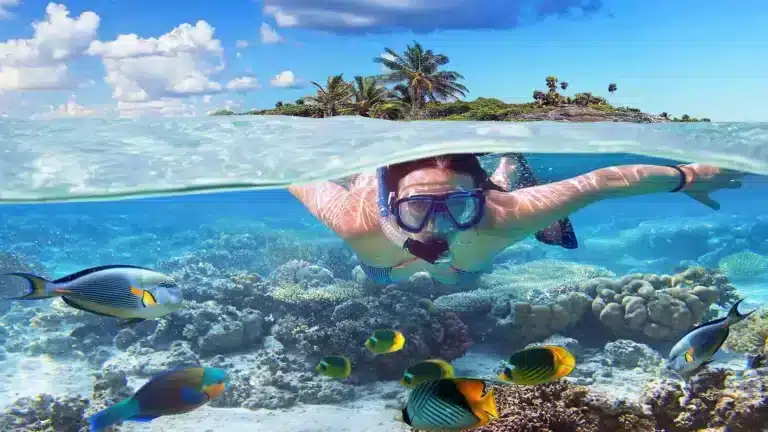
Diving on Klein Curacao
Klein Curacao is perhaps one of the most beautiful places on earth to go diving. Because it is an uninhabited island, the reefs are still virtually untouched and the water surrounding the island is even clearer than on the main island Curacao .
Diving on Klein Curacao without a diving certification
You do not need to be certified to dive on Klein Curacao . There is one trip with its own diving school on the island that offers a Discover Scuba Dive. We are talking about the VIP trip on the Serendipity . A Discover Scuba Dive is an approximately two-hour diving experience of which you will actually go diving at a maximum depth of 12 meters. Before this dive, you will receive a comprehensive explanation of the basic principles of diving and diving equipment. Then three exercises are explained which you will have to perform at a depth of about three meters. When this all goes well and feels comfortable, the instructor will take you and up to three other participants for the real dive.
Diving on Klein Curacao with a diving certification

A trip to Klein Curacao
trips to Klein Curacao have been organized for more than 35 years. The first two trips are also immediately the oldest and most complete trips. We are talking about the Serendipity and the Mermaid. On these trips, you may use the private beach house, with deck chairs, umbrellas, toilets and freshwater showers.
If you choose a Klein Curacao trip on one of the IRIE Times catamarans or the Blue Finn catamarans you will be dropped off on the island with no facilities. The ultimate Robinson feeling!
What is included in the excursion?
All excursions to Klein Curacao are all inclusive, there is an open bar throughout the day, at noon you get a BBQ lunch and on the way back to Curacao there is always happy hour. Usually you will then be offered a tasty cocktail.
The open bar always includes soft drinks, and some trips also include alcoholic drinks.
Departure points of the excursions
Each excursion has a different embarkation point. For example, you can travel from Jan Thiel beach, Santa Barbara beach or the Caracas Bay/ Spanish Water to Klein Curacao. The crossing takes about one to one and a half hours.
Dolphin and sea turtle spotting
Along the way, there is always a very good chance of encountering a pod of wild dolphins. We will then follow them for a bit or stop the boat to fully enjoy this magical spectacle.
During this beautiful day, you can go snorkeling by yourself and also join a snorkel safari. There is a very good chance of encountering sea turtles. Around Klein Curacao, you can always find sea turtles hiding very close to the surf.

A boat trip to Klein Curacao on a catamaran
Visiting an uninhabited island is a very special experience in itself. But now suppose it is possible to make that experience even more special. A boat trip to Klein Curacao on a catamaran.
A catamaran is a type of boat characterized by the two parallel hulls. This ensures that a catamaran is a lot more stable than a regular vessel and has lower drag, allowing a catamaran to reach higher speeds.
At the front of the catamaran are two large nets that you can lie on and see what is going on in the water directly below you. In fact, it is quite common to encounter wild dolphins along the way. But beware, in the nets, you are a lot more likely to get wet.
How exactly does this boat ride take place?
We do daily day trips to Klein Curacao with four catamarans from Jan Thiel beach or from the Spanish Water. On the way out, we are sailing against the current so the entire trip will involve the use of the engines. On the way back, depending on weather conditions, we will sail back to Curacao.
A boat trip to Klein Curacao on a catamaran will certainly give your visit to the bounty island an extra dimension.
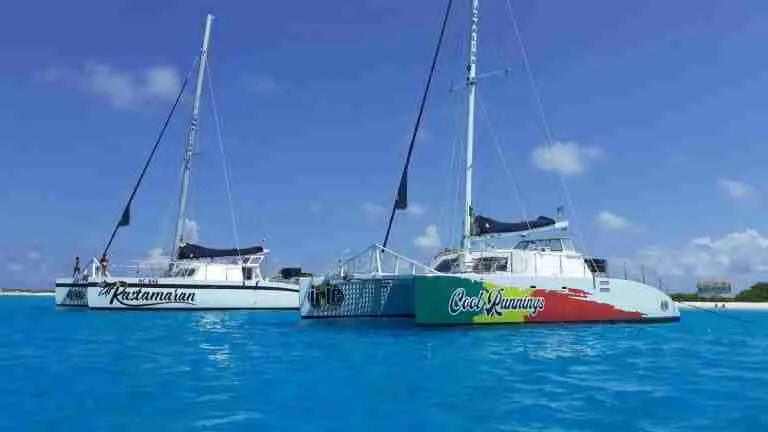
Klein Curaçao, conservation and tourism
The islet is very fragile, something we have to be very careful about. In the past, Klein Curaçao has been pillaged, especially by phosphate mining. This has had a great impact. International organizations have also commented on the unique qualities of Klein Curaçao with regard to biodiversity. The inestimable value of preserving this biodiversity and thus maintaining untouched coral and fish populations.
Klein Curaçao, a Ramsar area
Meanwhile, Klein Curaçao has been designated a Ramsar site. This is an international agreement on wetlands and their conservation. So Curaçao must now take responsibility for preserving it as a nature reserve. This entails not building more on Klein Curaçao, but looking at creative and sustainable ways to promote tourism to the bounty island.
Designating Klein Curaçao as a Ramsar site offers many advantages. First, it helps preserve biodiversity in the Caribbean, which already faces challenges from climate change and human activities. It also ensures the protection of seabird populations, which are crucial to the balance of marine ecosystems.
Moreover, Ramsar status will give Klein Curaçao international recognition as an area of global importance. This can increase the appeal for responsible tourism, focusing on conservation and sustainability. Tourists will be encouraged to visit the island and enjoy its natural beauty while respecting its fragile flora and fauna.
Local governments play a crucial role in managing the Ramsar area. Together with conservation organizations, they should strive to effectively enforce environmental protection laws, educate the public and monitor ecosystems. Moreover, international cooperation is essential to address transboundary threats such as illegal fishing and pollution.
The prospect of Klein Curaçao as a Ramsar site offers hope for the future of this beautiful island. By recognizing and protecting its ecological value, we can ensure that future generations can continue to enjoy the natural treasures it has to offer. Together we can set an example of sustainability and conservation for the whole world.
What to look out for on Klein Curaçao
So tourists are certainly allowed to go to Klein Curaçao, but because of course, they must follow the rules. Swimming, snorkeling and diving are allowed. However, tourists are expected not to touch the animals and corals. Also, the stretches of beach should be avoided where the turtles lay their eggs and no trash should be left on the island.
Conservation of Klein Curaçao’s biodiversity is very important. Should you decide to visit the island we would like to ask you to treat it with care and respect.
History
Although the islet is not that big nor has it been on the map for very long, it has a very interesting history.
The discovery of Klein Curaçao
The exact moment Klein Curaçao was discovered is unfortunately unknown. However, we do know from when the island was put on the map. This was in 1871 by an English mining engineer named John Godden. However, he did not just put Klein Curaçao on the map; he had a reason for doing so. In fact, he thought the island was important enough to put on the map primarily because of the phosphate found on the island. This was a highly sought after product, so there was a lot of profit to be made here on Klein Curaçao. In Europe, it was used in fertilizers and animal feed, among other things.

Quarantine Island
In the seventeenth and eighteenth centuries, the West India Company did a lot of trading overseas. In the process, they also transported slaves. However, sometimes it happened that slaves were sick and then they didn’t want more slaves to get sick. Thus, Klein Curacao came in handy for them. Before coming to Curacao itself, the sick slaves were taken to Klein Curacao so that they could be quarantined here. They also used Klein Curacao as a place to bury the slaves, if any slaves did not survive.
The weather on Klein Curacao
The weather and climate on Klein Curacao are about the same as on Curacao. For example, Klein Curacao has had relatively little trouble with hurricanes, although a violent hurricane did pass over the bounty island in 1877. This hurricane destroyed the island’s first lighthouse. After this, a new lighthouse was built and it can still be visited today. Also, northeast winds and strong currents have always occurred around the island. This has caused several ships to run aground on the bounty island. These shipwrecks can still be seen today on Klein Curacao. For example, there is a French sailing yacht named Tchao, which ran ashore on April 1, 2007.
- 23 June 2024
Frequently Asked Questions
How long do you sail to Klein Curacao?
How long is the sailing from Curacao to Klein Curacao ? Depending on the type of boat, it takes about 1 hour to 1.5 hours to sail from Curacao to Klein Curacao. Our catamaran makes the crossing in about 1.5 hours. The luxury yacht sails from Curacao to Klein Curacao in about 1 hour.
Is Klein Curacao worth it?
Is Klein Curacao worth it? The answer to this is actually quite easy. Spending a day on an uninhabited island is a unique experience in itself. But because this day is combined with seeing a number of impressive sights, swimming with sea turtles, spotting dolphins, a beautiful crossing on a beautiful boat and all-inclusive delicious food and drinks all day long, this makes a day trip to Klein Curacao by far the first place of things you must see or do during your holiday on Curacao . This trip was declared the most beautiful trip in the Caribbean by Lonely Planet in 2022. Hence the name Klein Curacao a Caribbean pearl .
What does a trip to Klein Curacao cost?
What does a trip to Klein Curacao cost? When you book a boat trip with us online you are always guaranteed the lowest price. Prices range from €99 to €130 per person. This depends entirely on the type of boat and the facilities offered during the day.
When am I eligible for a full refund on a trip?
Not satisfied after your tour? We offer a full refund! To be eligible for this refund, your request must meet our refund requirements.
What is there to do on Klein Curacao?
What is there to do on Klein Curacao? On Klein Curacao, you can see several things. Surely the most famous sights are the iconic lighthouse and the imposing shipwreck.
In a close second place is the beautiful stretched beach. The sand is even whiter than in Curacao and the views breathtaking. The beach was named the most beautiful beach in the Caribbean in 2019.
And finally, the crystal-clear waters with the pristine reefs, the exuberant and colorful underwater life and, of course, the large sea turtles that are always hiding close to the burn.
Is there shade on Klein Curacao?
There is definitely shade on Klein Curacao. There are several large palapas on the island and to the south are a few wooden enclosures where you can sit out of the sun.
There are also two private beach houses on the island with sun beds and umbrellas. However, you may use this only when you go with the Mermaid or the Serendipity.
Do you have coverage on Klein Curacao?
There are no transmission towers on Klein Curacao and the transmission towers on Curacao do not reach far enough. Therefore, there is no coverage on Klein Curacao. Also, there is no WiFi.
Which boat to Klein Curacao?
There are several boats that go to Klein Curacao. A few boats vorate daily, but most boats several times a week. Therefore, look carefully at the availability of the various boats.
With us it is possible to choose between a speedboat, the Bobcat, about four catamarans at the Blue Finn and IRIE times trip, a luxury motorboat, the Mermaid and the luxury yacht the Serendipity.
Are you sure you will see sea turtles and dolphins on a trip to Klein Curacao?
We cannot guarantee this, as they are wild animals in their natural habitat. So we have no influence on this. We can promise you, however, that the chances of seeing these animals are very high.
Is it possible to rent a boat privately?
Yes, all boats listed on our website can be rented privately. This is possible from €1800 for the whole day including captain with crew, open bar (all day) and a BBQ lunch. The daily rate depends on the boat chosen and the facilities desired. We will be happy to advise you on all options and associated costs.
How do you get to the island of Klein Curacao?
A trip to Klein Curacao is only possible by boat in the form of an organized trip. There are no ferry services to Klein Curacao.
Where is Klein Curacao located?
Klein Curacao is an uninhabited island and is located about 10 kilometers south east of Curacao.
How big is Klein Curacao?
The island has an area of 1.7 square kilometers. It is possible to walk around the entire island in about two hours.
Where do the boats leave from for a Klein Curacao tour?
Tours to Klein Curacao depart from the ports of Jan Thiel, Santa Barbara or Caracas Bay. There is ample parking at all ports in case you come with your own transportation. When you book a tour to Klein Curacao all the details and during are in the confirmation.
Is there electricity on Klein Curacao?
No, there are no power supplies on Klein Curacao.
Can you call or use the Internet on Klein Curacao?
No, there are no transmission towers that reach to Klein Curacao, nor are there any transmission towers or WiFi on Klein Curacao.
Do you need to bring your own towels?
Yes, you must bring your own towels.
Is there a restaurant or bar on Klein Curacao?
No, there are no restaurants or bars on Klein Curacao.
Can you only do a day trip to Klein Curacao or are there shorter trips?
There are only day trips to Klein Curacao. Usually the boats set sail between 07:00 and 08:30 depending on the day trip you have chosen. Between 16:00 and 17:00 the boats will be back in the port of Curacao.
What can you expect from the care?
A lovely island you will find in Klein Curaçao with great care including Premium Open Bar and delicious meals
Once arrived
Once you arrive at Klein Curaçao, you feel the stress of daily life slip away from you immediately. This remote island is an oasis of peace and beauty. The azure ocean stretches as far as the eye can see, and the soft, white sand caresses your feet as you walk along the shoreline.
Premium Open Bar
One of the highlights of visiting Klein Curaçao is the “premium open bar” often offered by tour companies visiting the island. While enjoying the sun and sea, you can treat yourself to refreshing cocktails and high-quality drinks, all included in your adventure. It is truly a treat to be on an island where you can quench your thirst with the best drinks while feeling the ocean breeze.
Delicious Breakfast
A day on Klein Curaçao usually begins with a “delicious breakfast” provided by the crew of your excursion boat. As you feast on fresh fruit, pastries and other treats, you can prepare for a day of adventure and relaxation. Breakfast overlooking the ocean is an experience in itself and immediately sets the tone for a great day.
Delicious BBQ Lunch
After a morning of swimming, snorkeling and sunbathing, there is usually a “delicious BBQ lunch” waiting for you. The smell of grilled fish, meat and local specialties fills the air as you enjoy a tasty meal with your fellow travelers. It is the perfect way to make new friends and enjoy the local cuisine.
Non-Alcoholic Beverages
Of course, those who do not drink alcohol are also considered, as “non-alcoholic drinks” are always available. Refreshing soft drinks, fruit juices and water are widely available so that everyone can enjoy a refreshing drink.
Top Day
In short, a day at Klein Curaçao is a “top day” you won’t soon forget. The island offers the perfect blend of relaxation, adventure and culinary indulgence. Whether you want to swim in the turquoise waters, explore the underwater world while snorkeling, or just relax on the beach with a cocktail in hand, Klein Curaçao has something for everyone.
So, if you are looking for a “lovely island” where you can enjoy a “premium open bar,” a “delicious breakfast,” a “delicious BBQ lunch” and “non-alcoholic drinks,” then Klein Curaçao is the ideal destination for you. Come and discover this paradise on earth and experience a “top day” you will cherish for a long time. No wonder many find Klein Curaçao a delightful island.
What tour operators are there?
Discover paradise Klein Curaçao with Miss Ann Boattrips, Mermaid Boattrips and Irie Tours Curaçao
Klein Curaçao, a small island southeast of Curaçao, is known for its pristine beauty and crystal clear waters. This island paradise is a must-visit destination for travelers seeking an unforgettable experience in the Caribbean. There are several ways to explore this little piece of paradise, but the most popular and reliable way is with Miss Ann Boattrips and Irie Tours Curaçao .
Miss Ann Boattrips , a renowned name on the island, offers the ultimate experience to explore Klein Curaçao. With their luxury motor yacht, you can enjoy the comfort and style while heading to this secluded gem. Miss Ann’s friendly crew is known for their warm hospitality and excellent service. They will ensure that your trip to Klein Curaçao will be unforgettable.
Another great option to explore Klein Curaçao is with Irie Tours Curaçao. This tour operator is known for its professional approach and knowledgeable guides. They offer several options for exploring Klein Curaçao, including day trips on the latest catamarans. These catamarans are comfortable and offer plenty of space to relax while enjoying the beautiful ocean views.
Mermaid Boattrips in Curaçao offers an enchanting experience for anyone who wants to discover the treasures of the Caribbean Sea. With their beautiful sailing yachts, they take visitors on adventurous journeys along the island’s azure waters. Whether you want to snorkel in colorful coral reefs, explore the underwater world or simply relax on the deck, Mermaid Boattrips has something for everyone. Their knowledgeable crew is also happy to share local knowledge and stories. Whether you are looking for adventure or relaxation, a day with Mermaid Boattrips in Curaçao promises memories for a lifetime.
Blue Finn Charters is yet another option for adventurous travelers. They offer exciting boat tours to Klein Curaçao and are known for their experienced captains and modern boats. Whether you are looking for adventurous water sports or just want to relax on a secluded beach, BlueFinn Charters has something for everyone.
What makes Klein Curaçao so special are its pristine beaches, crystal clear waters and diverse underwater world. Many of these providers organize snorkeling and diving trips, giving you the chance to admire the colorful coral reefs and tropical fish this region has to offer. Several providers on the island offer these exciting opportunities, allowing you to explore the underwater world of Klein Curaçao.
After a day of adventure on Klein Curaçao, enjoy a sumptuous bbq buffet prepared by the talented chefs aboard the boats. This is a great way to relax and enjoy delicious food while overlooking the azure sea.
Whether you choose Miss Ann Boattrips , Irie Tours Curaçao , Blue Finn Charters, Mermaid Boattrips , or one of the other various providers, a visit to Klein Curaçao will be an experience you will not soon forget. Explore the beautiful beaches, dive into the fascinating underwater world and enjoy the warm hospitality of Curaçao. With the latest catamarans and luxury motor yachts at your disposal, an unforgettable adventure awaits you on this enchanting island.
Summary
Klein Curacao: The Sun-drenched Bounty Island with the Most Beautiful Beaches
Klein Curaçao, also known as “Paradise Klein Curaçao,” is a delightful island destination that deserves its fame for its stunning natural splendor. This little paradise, known as a beautiful island, lies like a treasure in the Caribbean Sea and is the ultimate escape for travelers looking for sun, sea, and the most beautiful beaches.
Beautiful Island State Known
Klein Curaçao has a well-deserved reputation as a beautiful island destination. Just a short boat ride away from Curaçao, this sun-drenched bounty island offers an intimate experience on a small piece of paradise. The island is known for its natural beauty, highlighted by the most beautiful beaches you will ever see.
Most Beautiful Beaches
The most striking feature of Klein Curaçao is undoubtedly the abundance of pearly white beaches that adorn its coastline. These pearly white beaches surrounded by a blue sea are at the heart of the island’s appeal. They are the most beautiful beaches imaginable and provide the perfect setting for relaxation and adventure.
Pearl White Beach and Blue Sea
When you step onto the pearly white beach of Klein Curaçao, you will be amazed by the softness of the sand beneath your feet. The sight of the endless blue sea is breathtaking. This blue sea, which surrounds the easternmost point of the island, is inviting to both swimmers and water sports enthusiasts.
Delightful Island
Klein Curaçao is often described as a delightful island destination, and for good reason. It is a place where time seems to slow down and where you can immerse yourself in the beauty of nature. Whether relaxing on the pearly white beach, snorkeling in the surrounding waters, or visiting the historic lighthouse that graces the island, you will feel the charm of this delightful island.
Activities on Klein Curaçao
Klein Curaçao offers more than just beautiful beaches and blue sea. Snorkeling and diving are popular activities because of the beautiful marine life, while bird watchers enjoy the variety of seabirds that call the island home. The historic lighthouse, located at the easternmost point of Klein Curaçao, is also a must-see attraction for history buffs.
An Unforgettable Experience
A visit to Klein Curaçao guarantees a wonderful day, an unforgettable experience. This sun-drenched bounty island with the most beautiful beaches invites you to embrace the beauty of nature. Whether you spend the day on a pearly white beach, swimming in the blue sea, or exploring the island’s rich history, Klein Curaçao offers an experience that will stay with you forever. It is a paradise on earth, a place of pure delight for travelers who crave peace, beauty and adventure.

